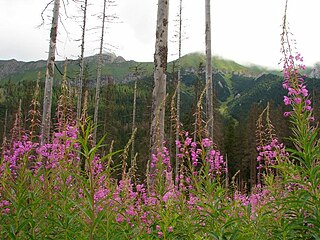
A woodland or wood is a low-density forest forming open habitats with plenty of sunlight and limited shade. Woodlands may support an understory of shrubs and herbaceous plants including grasses. Woodland may form a transition to shrubland under drier conditions or during early stages of primary or secondary succession. Higher density areas of trees with a largely closed canopy that provides extensive and nearly continuous shade are referred to as forests.
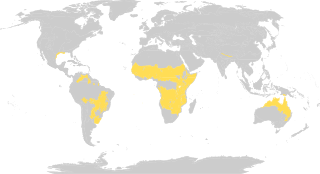
Tropical and subtropical grasslands, savannas, and shrublands is a terrestrial habitat type defined by the World Wide Fund for Nature.. The biome is dominated by grass and/or shrubs located in semi-arid to semi-humid climate regions of subtropical and tropical latitudes.

Tamarind is a leguminous tree bearing edible fruit that is indigenous to tropical Africa. The genus Tamarindus is monotypic, meaning that it contains only this species.
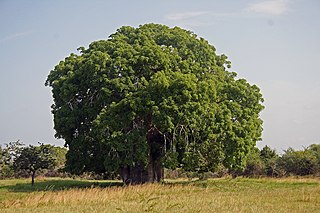
Baobab is a genus of deciduous trees known as adansonia. They are found in arid regions of Madagascar, mainland Africa, Arabia, and Australia. The generic name honours Michel Adanson, the French naturalist and explorer who described Adansonia digitata.
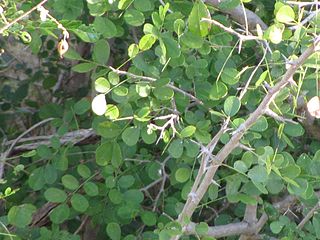
Dalbergia melanoxylon is a flowering plant in the family Fabaceae, native to seasonally dry regions of Africa from Senegal east to Eritrea and south to the north-eastern parts of South Africa. The tree is an important timber species in its native areas; it is used in the manufacture of musical instruments and fine furniture. Populations and genomic resources for genetic biodiversity maintenance in parts of its native range are threatened by overharvesting due to poor or absent conservation planning and by the species' low germination rates.

Shea butter is a fat extracted from the nut of the African shea tree. It is usually ivory in color when raw, with more processed versions being white in color. It can be yellow when borututu root, turmeric or dyes are added to it. It is widely used in cosmetics as a moisturizer, salve or lotion. Shea butter is edible and is used in food preparation in some African countries. Occasionally, shea butter is mixed with other oils as a substitute for cocoa butter, although the taste is noticeably different.

Adansonia digitata, the baobab, is the most widespread tree species of the genus Adansonia, the baobabs, and is native to the African continent. The long-lived pachycauls are typically found in dry, hot savannahs of sub-Saharan Africa, where they dominate the landscape, and reveal the presence of a watercourse from afar. Their growth rate is determined by ground water or rainfall, and their maximum age, which is subject to much conjecture, seems to be in the order of 1,500 years. They have traditionally been valued as sources of food, water, health remedies or places of shelter and are steeped in legend and superstition. European explorers of old were inclined to carve their names on baobabs, and many are defaced by modern graffiti.

Hagenia abyssinica is a species of flowering plant native to the high-elevation Afromontane regions of central and eastern Africa. It also has a disjunct distribution in the high mountains of East Africa from Sudan and Ethiopia in the north, through Kenya, Uganda, Rwanda, Burundi, Democratic Republic of Congo, and Tanzania, to Malawi and Zambia in the south.

Pterocarpus erinaceus is an endangered species of tree that is native to the Sahelian region of West Africa. It is listed in Appendix II of the Convention on International Trade in Endangered Species of Wild Fauna and Flora. It is used for fuel wood, for medicinal purposes, as a woodworking material, and is useful as a nitrogen-fixing plant to improve nutrient-depleted farming land. It has several common names, including kosso, barwood, African kino tree, muninga, and vène; mukwa is used for this species as well as other Pterocarpus. Groves of the tree can be found on the savannahs of West Africa, but it is becoming increasingly rare and is sometimes cultivated. The tree also grows in forests of Comoé National Park in Côte d'Ivoire, a region geographically close to the Sahel but with a higher moisture regime due to its location between two large rivers. Also, the tree grows in abundance in Kurmi Local Govt. of Taraba State in Nigeria. The tree grows to about 11 meters in height on average, and bears dark, scaly bark and yellow flowers. The fruits are winged pods. P. erinaceus grows well on sunny, hot African plains with long dry seasons and frequent fires.

Psilalonia is a square and neighbourhood in the central part of the city of Patras, 1 km direct and 1.5 km south via road from the downtown core. Psilalonia is linked 100 m from Gounaris Street. Psilalonia is famous for one of the city's most visited square that is of the same name. It features palm trees, playground, a fountain, a monument of Germanos III of Old Patras by sculptor Ioannis Kossos and restaurants. Other shops are by Gounaris Street.
Exochi is a community in the municipality Topeiros in the Xanthi regional unit of Greece. It consists of the settlements Exochi, Vaniano, Gkizela, Dafni, Kossos, Kypseli, Melissa and Nea Amisos.
Kossos is a settlement in the community Exochi, Xanthi regional unit, Greece. It is located northwest of Exochi and 13 kilometers southwest of Xanthi. In 1981, the population of Kossos was around 68 inhabitants. In 1991, the population slightly rose to around 76 inhabitants.

Sanaba is a department or commune of Banwa Province in western Burkina Faso. Its capital lies at the town of Sanaba. According to the 1996 census the department has a total population of 29,525.
Kosso is a village in the Sanaba Department of Banwa Province in western Burkina Faso. As of 2005 it had a population of 435.

Curtea is a commune in Timiș County, Romania. It is composed of three villages: Coșava (Kossó), Curtea and Homojdia (Homapatak).

Fresco is a town in southern Ivory Coast. It is a sub-prefecture of and the seat of Fresco Department in Gbôklé Region, Bas-Sassandra District. Fresco is also a commune.
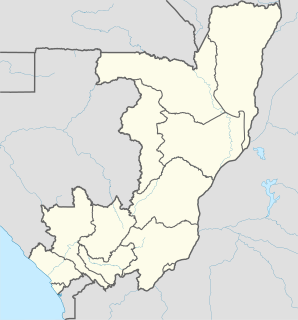
N'kosso is a small village situated in Mouyondzi District,some 250 km from the town called Nkayi in the Bouenza region of Republic of Congo.

Ioannis Kossos was a Greek sculptor of the 19th century. Born in Tripoli, he later studied in Athens and Florence. His work includes several statues and busts in Athens, Patras and other Greek cities.

Kossoh Town is a coastal village around the peninsular in the Western Area Rural District of Sierra Leone. The village lies about ten miles east of Freetown, and is in close proximity to the neighborhood village of Jui. Kossoh town seat around a large forest reserve. The major industry in the village is farming and coal mining.

Kosso Eloul born in Russia, 1920–1995, was an Israeli sculptor. His work displays a combination between the influence of "Canaanite" art and the abstractionism of the Ofakim Hadashim movement. He won the Dizengoff Prize for Sculpture in 1951.
















